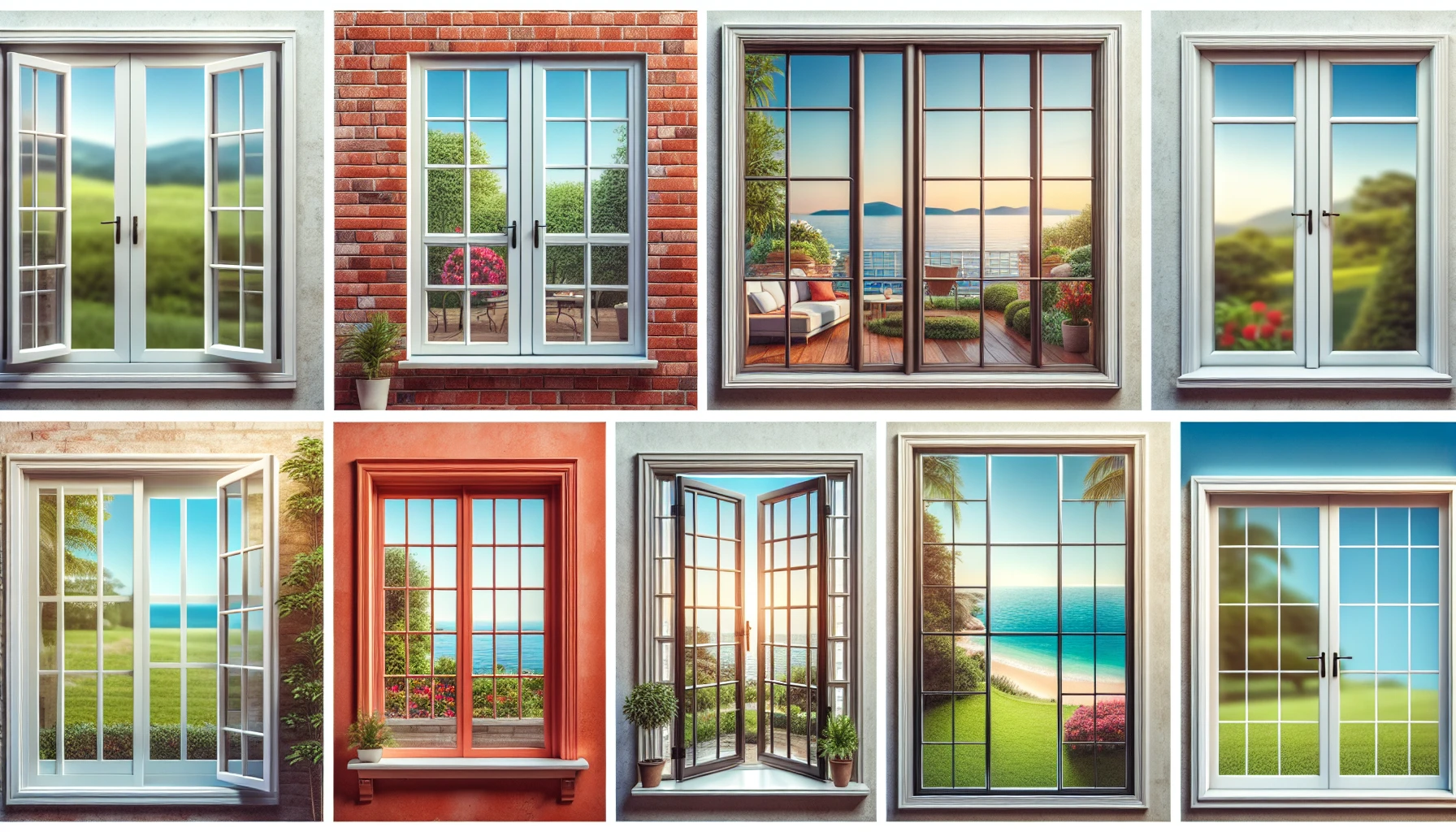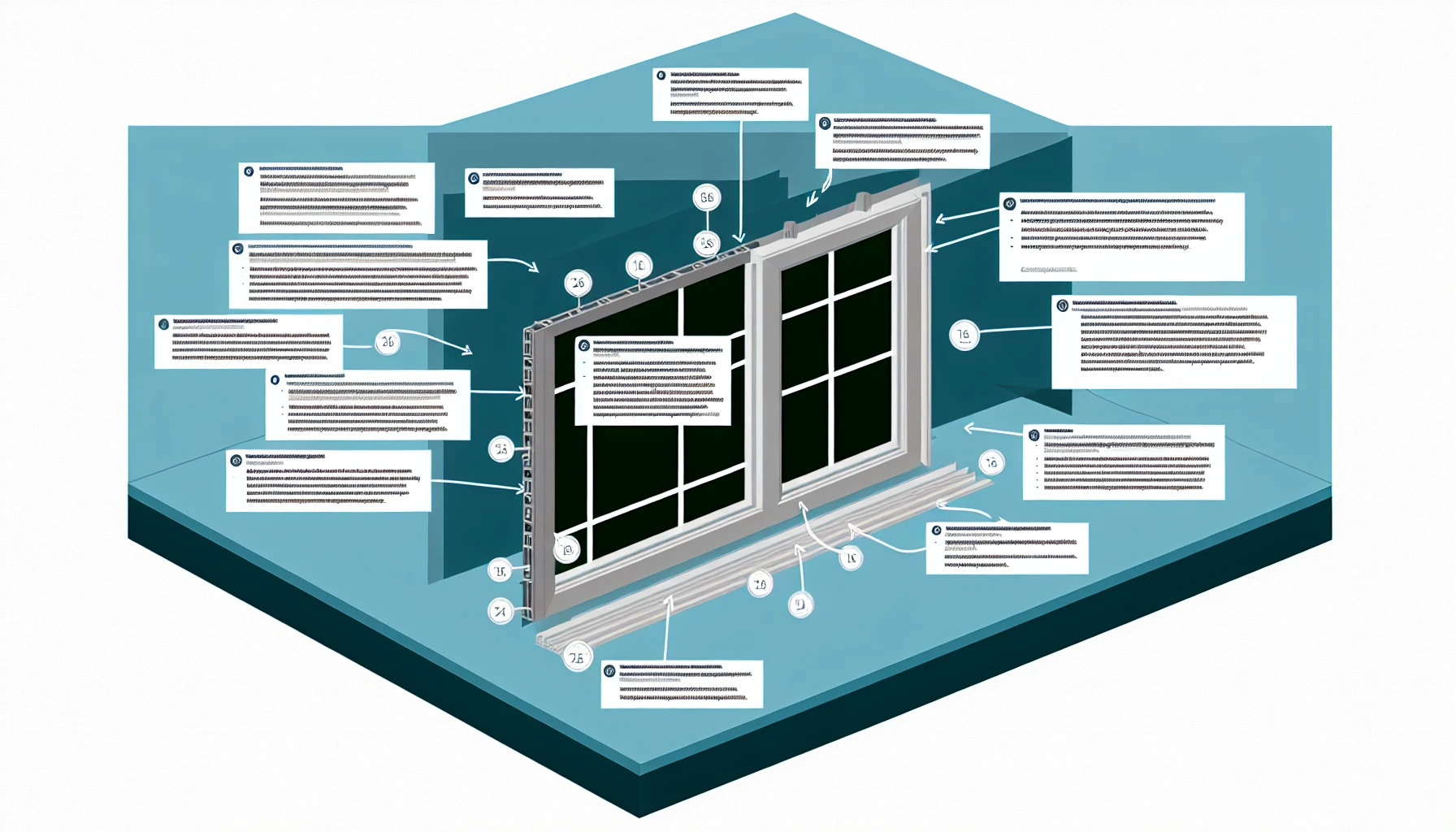Top Trends in Replacement of Windows for Energy Efficiency & Style in 2024
Are you considering upgrading your home’s windows to improve energy efficiency and enhance style? Then you’re in the right place! This comprehensive guide will walk you through the essentials of window replacement, including understanding the basics of the replacement of windows, selecting the right materials, decoding energy efficiency factors, and choosing popular window styles. By the end of this guide, you’ll be well-equipped to make informed decisions and boost your home’s value with stylish, energy-efficient windows.
Key Takeaways
- Understand the basics of window replacement and recognize when it’s time to replace windows.
- Consider material, energy efficiency, cost, and other factors when selecting new windows.
- Explore financing options & government/utility incentives for energy efficient upgrades to enhance home value & aesthetics.
Understanding Window Replacement Basics

Illustration of different window styles
Window replacement can provide a range of advantages, such as:
- Increased soundproofing
- Improved insulation
- Enhanced comfort
- Upgraded aesthetic
Energy-efficient replacement windows can also help reduce energy consumption and lower utility bills. When it comes to choosing the best replacement windows, there are various types of windows available, such as vinyl, wood, and fiberglass, each offering unique benefits and drawbacks.
Understanding your options can guide you to make the most suitable choice for your home.
Recognizing When to Replace Windows
Recognizing the right time to replace your windows is key to maintaining your home’s comfort and efficiency. Generally, it’s recommended to replace windows every 15 to 20 years. Some signs that it’s time for window replacement include:
- Drafts
- Condensation
- Difficulty opening and closing
- Visible damage
- High energy bills
Before making a decision, consider factors such as window type, size, shape, material, energy efficiency, and cost.
The Step-by-Step Window Replacement Process
The window replacement process involves several steps, from selecting the right materials to installing replacement windows, ensuring proper installation. First, set a budget for the project and identify the windows to be replaced.
Next, choose the most suitable window type for your needs and evaluate the energy efficiency of the materials by looking for the NFRC label and Energy Star label.
Finally, hire a qualified installer to guarantee proper installation and review the warranty offered for the replacement materials.
Selecting the Right Material for Your New Windows

Illustration comparing wood, vinyl, and fiberglass windows
As you select the appropriate material for your new windows, there are several options to consider, such as:
- Wood frames
- Vinyl frames
- Fiberglass frames
- Composite frames
Each material has its own set of advantages and disadvantages, which should be weighed carefully before making a decision.
As we proceed, we will detail each material, providing you with the information you need to make the best choice for your home.
Wood vs. Vinyl vs. Fiberglass Windows
Wood frame windows offer a classic look and allow for the interior to be painted or stained, providing customization options. However, wood windows require more upkeep than other materials and can be more expensive.
Vinyl windows, on the other hand, are a cost-effective solution and require minimal maintenance. However, they may not be as resilient as wood or fiberglass windows and can be susceptible to warping and discoloration over time, which is why some homeowners consider vinyl replacement windows.
Fiberglass windows provide an aesthetic similar to that of a solid wood window, while offering a more reliable structural foundation. They come in three standard colors and feature even coloring on both the interior and exterior surfaces. Although fiberglass windows can be more costly than vinyl windows, they offer excellent insulation, weather resistance, and energy efficiency.
Aluminum and Composite Windows: Pros and Cons
Aluminum and composite windows are other options worth considering for your home. Aluminum windows are lightweight and durable, but they may not be as energy efficient as other materials.
Composite windows, made from a blend of materials like particleboard or laminated strand lumber combined with resin or fiberglass, boast strength and durability. However, they also require more upkeep and may be more expensive than other options.
Decoding Energy Efficiency in Window Replacements

Photo of a home with energy efficient windows
Energy efficiency is a significant factor to consider during window replacement, as it can contribute to energy savings and reduced utility bills. As we proceed, we will discuss the significance of Energy Star certified windows along with technologies that make windows energy-efficient, helping you better understand the benefits and make informed decisions for your home.
Energy Star Certified Windows and Their Benefits
Energy Star certified windows have been evaluated, certified, and validated according to the protocols established by the National Fenestration Rating Council (NFRC) and are regarded as the industry’s highest rating for highly efficient energy-efficient windows. These windows can provide extended energy savings through the reduction of heat loss, as well as features like low-e coatings, argon gas, and double- or triple-pane glass.
Technologies Behind Energy Efficient Windows
Several technologies contribute to the energy efficiency of windows, such as:
- Low-e coatings, which reduce heat transfer and help maintain comfortable indoor temperatures
- Argon gas, which is often used to fill the space between double- or triple-pane glass, providing additional insulation
- Double- or triple-pane glass, which creates a barrier against heat transfer and improves insulation
These technologies help reduce energy consumption for heating and cooling.
Argon gas, denser than air, is added to the glass unit in double- or triple-paned windows to reduce heat transfer and improve energy efficiency.
Popular Window Styles and Their Features

Illustration showcasing popular window styles
There are several popular window styles to consider for your home, each with its own unique features and benefits. We will proceed by discussing the versatility of double-hung windows and the benefits of casement and awning windows to maximize ventilation and natural light. Understanding these popular styles can help you make the best decision for your home’s aesthetics and functionality.
Double Hung Windows and Their Versatility
Double-hung windows are incredibly versatile, offering increased ventilation and flexibility in opening and closing both the top and bottom windows. This design allows for an excellent flow of fresh air and improved airflow compared to single-hung windows.
Their practicality and adaptability make double-hung windows a popular choice for various home styles.
Casement and Awning Windows: Maximizing Ventilation
Casement and awning windows offer optimal ventilation and natural light, as they open outwardly to the fullest extent, allowing for the most sunlight to enter the space. Casement windows provide precise control in terms of air direction and intensity, allowing for superior airflow in a room.
Awning windows can be securely left open during the night for improved air circulation and ventilation.
The Cost Factor: Estimating Your Investment in Replacement Windows

Photo of a window replacement cost breakdown
Accurate cost estimation is a key aspect to consider when planning a window replacement project. Factors that affect the cost of window replacement include the window’s location, the size of the home, and the time of year. We will now provide a breakdown of window replacement costs, including materials, labor, and additional expenses, as well as tips for getting accurate estimates.
Replacement Windows Cost Breakdown
Window replacement costs can vary greatly depending on the type of window, the size of the window, and the labor costs associated with the installation. On average, replacement windows cost around $700 per window, including materials and labor. However, the cost can range from $234 to $1,387 per window, depending on the window type and other factors that may influence the price.
In addition to the cost of the windows themselves, other expenses may include:
- Delivery
- Disposal of the old windows
- Potential modifications to the framing
- Repairs that may be necessary
- Permits
- Access to the windows for installation
The labor cost makes up an average of 15% of the total window replacement. It can range from $100 to $400 per window.
How to Get Accurate Estimates for Window Replacement
To ensure accurate estimates for window replacement, we recommend following these steps:
- Utilize a cost calculator like the one provided by Modernize and take into account factors such as window size, type, materials, and labor.
- Accurately measure the window and subtract 1/4 inch from each measurement.
- Look for labels like NFRC and Energy Star to ensure energy efficiency.
- Finally, seek out a reputable installer and evaluate the warranties offered.
Obtaining precise estimates from window replacement professionals is key to determining the accurate costs for your project. Potential risks in DIY window installation may include:
- Inaccurate measurements of the window opening
- Failure to adhere to the manufacturer’s instructions
- Gaps around the replacement windows
- Incorrect window size ordering
- Inadequate flashing adherence
- Lack of sealing of the nailing fins
Professional Installation vs. DIY: Making the Smart Choice
Though DIY window installation may appear appealing, one must consider the potential risks and challenges involved. Hiring a certified installer, such as CoMo Premium Exteriors, ensures the quality of the work and could avert potential issues in the future.
We will now discuss the risks associated with DIY window installation and the benefits of hiring certified installers.
The Risks of DIY Window Installation
DIY window installation may seem cost-effective, but it comes with several potential risks and challenges. Here are some of the potential issues you may encounter:
- Errors in the installation process can lead to property damage.
- Errors in the installation process can lead to severe personal injury.
- Choosing the wrong window for your needs can result in poor performance and energy inefficiency.
- Improper installation can result in drafts, leaks, and other issues.
- The installation process may take longer than necessary, particularly for those without prior experience.
Considering these risks, it may be worth hiring a professional for your window installation needs.
The Value of Certified Installers
Certified installers possess the expertise and understanding to guarantee that the window replacement project is carried out correctly and securely. They are also familiar with the most recent technologies and techniques, which can facilitate the project being completed expeditiously and with the best quality outcomes. CoMo Premium Exteriors employs knowledgeable installers who are authorized for the chosen brand and provides a 5 Year Workmanship Warranty.
Hiring a certified installer offers several benefits for your window replacement project:
- Ensures a successful installation
- Helps avoid the risks associated with DIY installation
- Provides peace of mind knowing your windows are being installed correctly
The investment in a professional installation service is well worth it for these reasons.
Enhancing Home Value with Stylish Window Upgrades
Upgrading your home’s windows can not only improve energy efficiency but also enhance your home’s overall aesthetic appeal and boost its value. Selecting the right window design and style is vital to achieving the desired look and feel for your home.
We will now discuss the influence of window design on home aesthetics, and provide tips for selecting windows that enhance your home’s architecture.
The Impact of Window Design on Home Aesthetics
Window design can significantly contribute to a home’s curb appeal. Replacing windows can give the home a modern and refreshed appearance, while also complementing the home’s architecture and adding visual appeal to the exterior.
Choosing the right window design can truly transform your home and elevate its overall look.
Choosing Windows That Complement Your Home’s Architecture
Selecting windows that complement your home’s architecture is essential to creating a harmonious visual aesthetic. For example, suitable windows for a Craftsman home include:
- Double-hung windows
- Casement windows
- Rectangular windows
- Square windows
By taking into account your home’s architectural style and choosing windows that enhance its features, you can create a stunning, cohesive look that increases your home’s value and appeal.
Financing and Incentives for New Windows
Window replacement can be a significant investment, but there are financing options and incentives available to help make the process more affordable.
We will now explore a variety of financing options for window replacement projects and discuss government and utility incentives for energy-efficient windows.
Exploring Window Replacement Financing Options
When considering financing options for window replacement, you may wish to explore:
- Personal loans
- Home equity loans
- Home equity lines of credit (HELOC)
- Credit cards
Many window manufacturers and installers offer financing options for people who want to replace their windows. These options make it easier to afford window replacement.
A home equity loan is a viable option to finance a window replacement project. It allows you to borrow money based on the equity in your home with a low-interest rate and is repaid over time. Be sure to research and compare the terms and interest rates of different financing options to determine the best fit for your needs.
Government and Utility Incentives for Energy Efficient Windows
There are government and utility incentives available to help offset the cost of energy-efficient window upgrades. Federal income tax credits are available through 2032, providing up to $3,200 annually to lower the cost of energy-efficient home upgrades. Various utility companies also offer rebates or incentives for energy-efficient windows, which are often provided through energy incentive programs offered by utilities, local governments, and state agencies.
Summary
In conclusion, upgrading your home’s windows can significantly improve energy efficiency, enhance style, and boost its value. By understanding window replacement basics, selecting the right materials, decoding energy efficiency factors, and choosing popular window styles, you can make informed decisions for your home. Don’t hesitate to invest in stylish, energy-efficient windows that will transform your living space and provide lasting benefits for years to come.
Frequently Asked Questions
Is it cheaper to replace all windows at once?
Replacing all windows at once is usually the more cost effective option, as many window replacement companies offer bulk pricing on both materials and labor. This means you will pay more upfront, but it could save you money in the long run.
What are some signs that indicate the need for window replacement?
Drafts, condensation, difficulty opening and closing, visible damage, and high energy bills are signs that replacement windows may be needed.
What factors should be taken into account prior to making a decision to replace windows?
When making a decision to replace windows, type, size, shape, material, energy efficiency, and cost should be taken into account.
What are the benefits of Energy Star certified windows?
Energy Star certified windows provide substantial energy savings by reducing heat loss and featuring low-e coatings, argon gas, and double- or triple-pane glass.
What financing options are available for window replacement?
Financing options for window replacement include personal loans, home equity loans, HELOCs, and credit cards.

